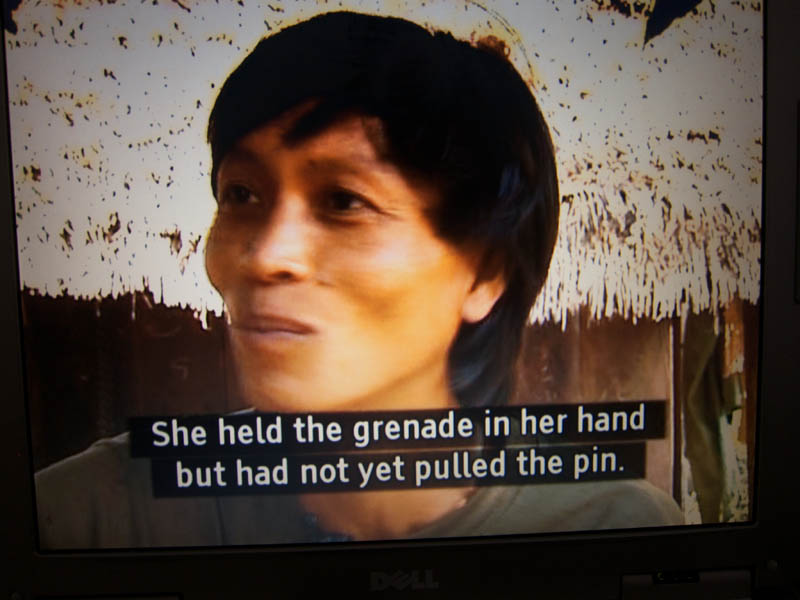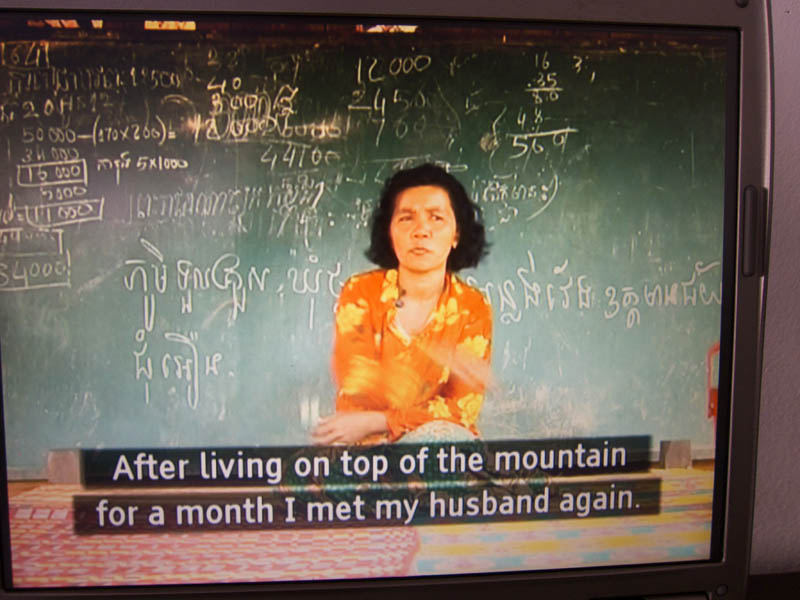
“Voices of Khmer Rouge” is a 43-hour-long media installation containing 30 personal narratives by former low ranking Khmer Rouge cadres about their lives, thoughts, ideologies, human values, feelings, actions, and experiences during the 33-year-long civil war in Cambodia and up to this day. The work consists of 30 monitors, one for each narrative. The “Voices of Khmer Rouge” project is placed in the cross-field between art, media theory, history, and information. It has historical as well as contemporary relevance. Implicit in the work is the more theoretical aspect of communication as such, represented by the volume and character of the work. By placing such a document in art museums, a cross reference will spontaneously occur between the project as a document and the project as a work of art, and several leads could be followed from there depending on the individual receiver.
Apart from being a work of art, the “Voices of Khmer Rouge” is also intended as a study document for researchers in the form of video tapes, DVDs etc. in public archives, universities, film institutes and the like. As such specific professional groups as historians, art historians, journalists, media researchers, sociologists, psychologists, anthropologists, and other professionals may take an interest in the document. Finally, by showing it in Cambodia it will have another and more direct impact, and the target group would be virtually every Cambodian. The document would become an exchange between “victim” and “perpetrator” in a “neutral” room. Such an exhibition of the work would be supposed to have a healing effect on the individual Cambodian. Many Cambodians still carry traumatic sufferings of sorrow and hatred related to the war, and very few are capable of talking freely to one another about it.
The history of “Voices of Khmer Rouge”:
From December 2002 through May 2003 we shot the Khmer Rouge interviews on location in the north-western and northern parts of Cambodia along the Thai border. These land mine infested regions were until recently the last remaining strongholds of the Khmer Rouge in the 33-year-long bloody civil war. With the aid of our interpreter Leang Kham - himself a former Khmer Rouge cadre and military medic - we located and interviewed 30 ex-Khmer Rouge who agreed to answer our questions. For the first time, they spoke publicly about their lives and experiences with the Khmer Rouge organisation.
The public image of the Khmer Rouge:
Khmer Rouge as an institution appears in history books worldwide as one of the universal incarnations of evil. Invariably when the Khmer Rouge is mentioned, a horrific picture appears. Something incomprehensible: A picture of a unified mass of killers guilty in the murders of nearly 3 million people. Anybody with any attachment to the Khmer Rouge is considered an inhuman monster. This overwhelmingly monochrome picture is presented in the vast majority of works on the Khmer Rouge - in history books, films (such as “The Killing Fields”), and newspaper articles alike. With our project we have - in all modesty - attempted to add a few more nuances to this picture.
The basic aim of the project:
Our aim with this work has been to let the ordinary Khmer Rouge members get a chance to relate their own personal accounts of their experiences with the Khmer Rouge organisation. Today they live as historical losers on the outskirts of the Cambodian society, without access to communicative media and written history. Are there human faces behind the monstrosities, the thousands of skulls exhibited in memory of the terrors of the Khmer Rouge regime, or were they indeed all murderers? How does the ordinary Khmer Rouge person understand and describe his/her own part in these historical events? How do they regard themselves? What do they remember? How do they remember?
Method:
We asked our interviewees to proceed chronologically, and we divided our questions into chapters from childhood up to the present day. We chose to put our questions in this way in order to stimulate long sequences of memory because we believe that this will benefit the overall presentation. We edited the raw video material as little as possible in order to let the stories follow their own rhythm whether it be broken or smooth, depending on the personality of the narrator/interviewee. By doing this we were aiming at staying true to the original document where playing time equals recorded time. The time of the narrator/interviewee will roughly equal that of the spectator.
The narrators and the chronology of the narratives:
The 30 narrators are between 38 and 70 years of age. There are 12 women and 18 men. All of them belong to the peasant class or lower middle class. All belong to the last remaining group of Khmer Rouge who surrendered to the government only a few years ago. The majority are today making a living as farmers, often with other secondary incomes.
The narratives are set against the following historical background:
- until 1953: Late French colonial period and Issarak movement 1954-1970: Independence and Sangkum Reastr Niyum – Prince Sihanouk’s regime and time in power, often regarded as modern Cambodia’s “Golden Age”. There were, however, frequent and severe crackdowns on political dissidents. 1970-1975: Coup d’Etat against Prince Sihanouk. General Lon Nol takes power. Civil war between the Khmer Rouge resistance movement supported by North Vietnam and China, and the Lon Nol government forces backed by the south Vietnamese and heavy American bombings. 1975-1979: The Khmer Rouge seize power. Pol Pot is leading Cambodia. The country is devastated and shut off from the outside world. Purges, forced labour and migrations, collectivisation, and border skirmishes with the Vietnamese.
1979-1989: The Vietnamese liberate/occupy Cambodia. Fighting between Vietnamese troops and the Khmer Rouge. The Khmer Rouge is supported by the United Nations, the United States and others. Large Khmer Rouge refugee camps are set up in Thailand. 1989-1999: Fighting between the troops of the present prime minister (and former Khmer Rouge) Hun Sen, and the Khmer Rouge. The United Nations intervene, and the first democratic elections are held in non-Khmer Rouge territories.
2000 - Present time and peace. Preparations for the international trial against the former leaders of the Khmer Rouge who are being charged with crimes against humanity (genocide). Within this framework the interviewees relate their personal stories from early childhood until today. Why they joined the Khmer Rouge. How the Khmer Rouge affected their lives for better or worse. What kind of ideals they found in the teachings of Pol Pot. About the war, the victories, and the defeats. Every one of them has enough experiences to fill a whole lifetime, mentally speaking. At the end they talk about life in Cambodia today and touch upon political, economical and social conditions seen from their own personal perspectives. They talk about the UN sponsored trial against the old Khmer Rouge leadership and their feelings about it. All of the stories are unique and share a common theme at the same time. They are 30 autobiographies with reflections about life, ideas, feelings and actions during three decades of civil war. To this day there is a widespread mistrust amongst Cambodians. Few know for sure who is a victim and who is a perpetrator. Nobody trusts each other. Large segments of the population are traumatised.
The thematic parts of the work:
We find that the work has several facets, and we would like to highlight six of them here:
1. The personal narration.
The work seen as an exchange of human experiences - in this particular case experiences during more than thirty years of civil war: geopolitical consequences in a microcosm. We learn about each individual’s emotional and mental conditions, and socio-cultural associations.
2. Historically.
The statement of the work is historically linked to the Vietnam War and its lasting implications, especially in the United States and France in the Western world, and Cambodia, China and Vietnam/Russia in Asia.
3. Contemporarily.
The work as a statement and commentary to the political present in Cambodia, and its vulnerable democratic condition. And as a statement and commentary to the upcoming international UN supported tribunal in Phnom Penh.
4. Media theoretically. How history is written.
What is representation / audio visual representation? Audio visual history writing? History writing? And the conditions for representation: how is information delivered through the media? Who has access to deliver information through the media? Who do not have access to deliver information through the media, in this case history writing as national / international self-understanding? Who is writing the history?
5. Ethnographically.
The narrator’s own autobiographical construction, the monologue.
6. Artistically.
Only the universe of art seems capable of containing a work of these dimensions, where conventional representations are being challenged. The work on display - its images, setup, and possible receptions: The motives/recordings displayed are very simple. One camera has been fixed on a tripod to capture the person in total in his/her home environment, like a naturalistic painting/picture/photo with the person’s life immediately visible around him/her. For example a man telling the story of his torture while his children are playing lazily behind him. More than a third of the men appear as disabled after land mine accidents - a dimension of simple implicit information. The other camera has been hand held and used solely to portray the face/voice and the mimetic expression - what story does the face tell? What story do the eyes tell? What do they mirror? The recorded material of the two cameras has been mixed in order not to disturb the spoken word.
The setup of the work is simple but flexible. It consists of 30 units, one unit consisting of a video projector or monitor, a speaker with a narrow sound emission (so as not to disturb others), and a DVD player. One unit for each recorded person. The 30 units can then be arranged according to specific wishes, as a linear presentation, or scattered across a given exhibition space. The setup will be adapted to the given room. The end-receiver may perceive the work as an overwhelming amassment of individual statements - the different voices, the sheer volume of material to be digested before the usual process of discriminate selection and generalisation has taken place. How many statements are required to make a whole? How many to create uncertainty?
One may become absorbed in one story only, or move around randomly and pick bits and pieces according to ones desire and fancy. The experience will thus be based on coincidence (where and when does one step into a story), as well as on ones personal references - which interests and previous experiences does one bring into a given narrative and into the work as a whole? “Voices of Khmer Rouge” was filmed during 2002-2003, edited, translated and subtitled 2004-2008, and finalised in 2011.

| Attachment | Size |
|---|---|
| krogsgaard1.jpg | 97.98 KB |
| krogsgaards.jpg | 83.98 KB |